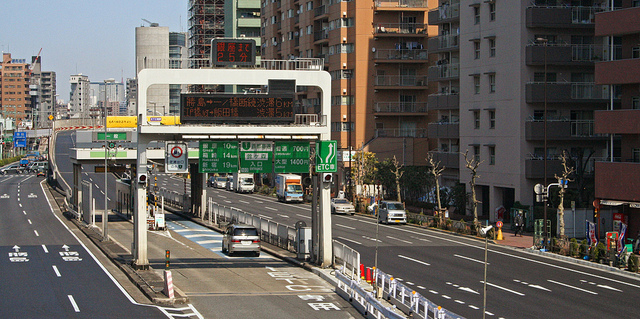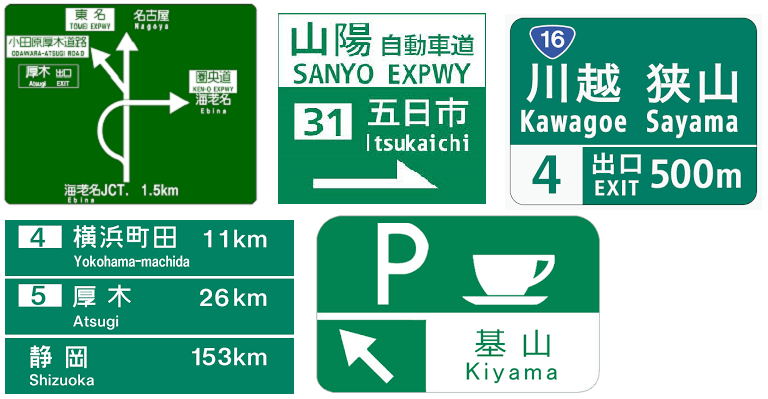
When you travel a long way to a resort or other tourist destinations in Japan, you can hardly avoid toll roads. The majority of expressways in Japan are toll roads, therefore you are most likely to drive through toll gates when you go on an outing by car. But it is Japan, not your home country, you may feel a little unconfident about how to pay at a toll gate, whether you can understand traffic signs alright, or other minor things. Don’t worry, driving on Japanese toll roads is not very complicated. This time, we will revise the basics about toll roads in Japan.
Toll roads in Japan
Most of toll roads in Japan are expressways with speed limit of 80-100kph creating massive networks within Honshu, Hokkaido, Shikoku and Kyushu Islands as well as connecting Honshu-Shikoku, Honshu-Awaji Island-Shikoku and Honshu-Kyushu. Also, there are many toll roads that connect major cities and tourist destinations or resorts.
Traffic signs on toll roads
In Japan, the background color of traffic signs of toll roads is green (some of expressways with green traffic signs are toll free). Same as general roads, there are some important traffic signs to know before driving on toll roads.

- Expressway (EXPWY)
- Interchange (IC): Entry/exit of toll roads, often toll gate
- Junction (JCT): Intersections of expressways
- Parking area (PA): Parking lot, toilets, light meal stands are available
- Service area (SA): Parking lot, toilets, gas station, restaurants are available
- Through traffic (Thru Traffic): General term of driving lane and passing lane excluding acceleration lane, deceleration lane, slow traffic lane and road shoulder
Parking area/service area signs
Some rest areas just have as minimum facilities as parking lot and toilets, while others are filled with facilities such as gift shops, a gas station, restaurants, snack corners and more. To decide whether or not to drop by a rest area, check a parking area/service area sign on the expressway while driving to see what facilities the closest rest area has.

- Parking lot
- Gas station
- Restaurant
- Information: check traffic information and tourism information in the area, time required to destination
- Snack corner
Ways to pay
When you get on a toll road, you must pass though the automatic ETC (Electronic Toll Collection) gate or the manual gate with ticketing machine. To get off the toll road, you drive through the ETC gate if you did so at the entry, or pay by cash or credit card at the manual gate with a pay machine or an attendant.
ETC
If your car is equipped with ETC system, simply drive through the gate with the word “ETC” in white on the purple background. You need to slow down to 20kph before pass through the gate, otherwise the gate will not react to open. To use ETC system, your car need to be equipped with an ETC device with an ETC card inserted in it. The card must be registered beforehand. If you are driving a rental car, you can rent an ETC card and pay for tolls when you return the car.
※Very occasionally, you may not be able to use the ETC gate due to breakdown. In such a case, just take a ticket at the manual gate if it is the entry gate, and give your ETC card to an attendant if it is the exit gate.
Cash/Credit card
If you are paying by cash or credit card, proceed to the manual gate with the word “一般“ in white on the green background. Insert your ticket into the machine at the gate, then pay the amount displayed on the machine. If you are using the gate with an attendant, simply hand in your ticket and pay.
About rest areas
After a long driving, it is very common that you lose your concentration or feel fatigued. Don’t force yourself to go on if you detect any of these. Instead, you should drop by a rest area. Many of service areas on the expressway have shops selling local gourmets and specialties. Some of them have been structured as if amusement parks, or have observation decks. These rest areas are so well designed, so you may be wanting to get on the toll roads just to visit these rest areas. The followings are examples of popular rest areas.
- Hanyu SA (Tohoku Expressway, Saitama): Popular for the replica township of the Edo period
- Ebina SA (Tomei Expressway, Kanagawa): It is more like a large shopping complex than SA. Many shops and restaurants are available.
- Fujikawa SA (Tomei Expressway, Shizuika): Popular for the beautiful view of Mt Fuji. The view of Suruga Bay from the ferris wheel on the inbound line is also great.
- Awaji SA (Kobe-Awaji-Naruto Expwy, Hyogo): Good foods from snack stands and the great view of the Akasi Kaikyo Bridge.
- Koga SA (Kyushu Expressway, Fukuoka): Modern exteriors and many shops of specialties and local food of Kyushu Island.
Dos and Don’ts on expressway
No stopping, no parking, no driving on road shoulder
Except for PA, SA and toll gates, stopping and parking is strictly prohibited on all expressways including toll roads. You must pull over on road shoulder in case of emergency. Driving on road shoulder is prohibited as well.
Flash hazard lights at the end of a traffic jam
When you come to the end of traffic congestion, flash hazard lights to notify drivers behind your car. If a car in front of you flash hazard light when the traffic is slow, it is a sign for traffic jam, not emergency.
The right lane is for passing
When there are a few lane on one side, the right lane is for passing. You must drive on the left lane unless you are overtaking other cars.
Mind other cars when using high beam
Japanese police recommends using high beam on expressways, however, it may distract drivers on the opposing lane. You may need to refrain from using high beam depending on the situation.
My way, or the highway
Other than that you have to pay, Japanese toll roads are not so different from highways in your country. If you are with ETC system, there is no need to worry if your credit card is accepted, or if you have enough cash on you. Just check the route to your destination, then you are ready to go. Well, this is not just limited to foreign drivers. By the way, don’t forget to slow down to 20kph when getting through the toll gate. If you drive at 40kph as you do in your country, you will end up getting the attendant to open the gate for you.
Related Article:
Three options for foreigners to drive a motor vehicle in Japan
Check before driving! Traffic offences in Japan
Driver license: Procedures to update residential address when moving house
Driving tips in Japan: Gas Stations
Driving tips in Japan: Car parks
Driving tips in Japan: General roads
Driving tips in Japan: Car accident
Driving tips in Japan: Traffic ticket
Unlimited use of expressways! Japan Expressway Pass for foreign tourists
Touring Japan by car: Rental-car guide for tourists
Best for driving trip! Regional expressway passes
Stuck on the road? Call JAF for roadside assistance
If you are buying a car in Japan: Guide to Japanese car insurance
What are insured? Check this before hiring a car in Japan
Japanese people no longer into owning cars? Car sharing in Japan
BRRR-lliant holiday in Japan! Rental motor bike
Comfortable camping in winter! Renting campervan in Japan
Get first driver license in Japan! Driving lessons in English
Selling a car? Get your car transported
